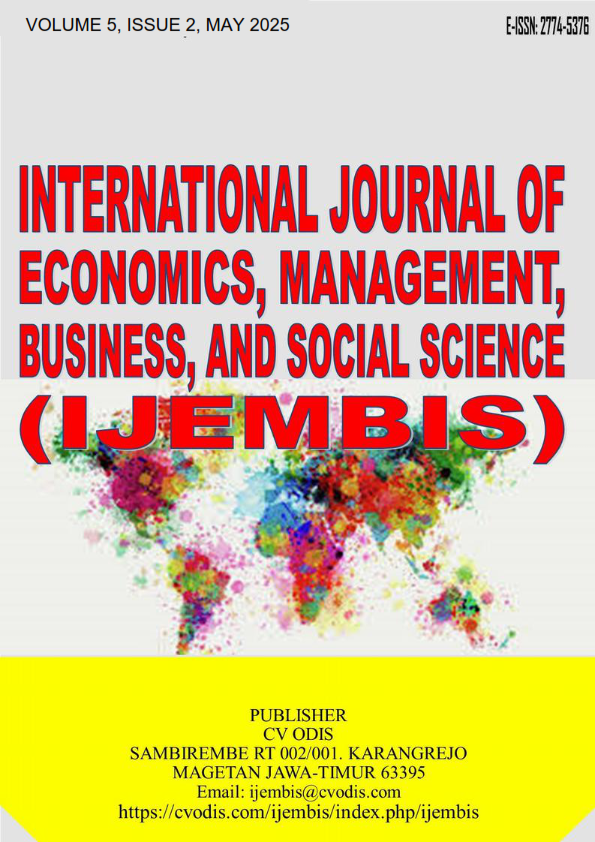The Impact of Compensation and Career Development on Employee Retention in Educational Institutions
A Case Study At PT XYZ
DOI:
https://doi.org/10.59889/ijembis.v5i2.456Keywords:
Compensation, , Career Development, Employee Retention, Human Resource Management, Educational InstitutionsAbstract
Employee retention is a crucial factor in maintaining organizational stability and competitiveness. This study aims to analyze the influence of compensation and career development on employee retention at PT Rumah Belajar Indonesia. The research employs a quantitative approach using survey data collected from employees. Data analysis is conducted using multiple regression to determine the extent of the impact of compensation and career development on retention. The findings indicate that both compensation and career development have a significant positive effect on employee retention. Competitive compensation packages and well-structured career development programs enhance job satisfaction and organizational commitment, leading to lower turnover rates. These results highlight the importance of implementing effective HR strategies to improve employee retention. The study provides valuable insights for HR practitioners in designing policies that foster long-term employee engagement and organizational sustainability.
Downloads
References
Armstrong, M., & Taylor, S. (2020). Armstrong’s handbook of human resource management practice (15th ed.). Kogan Page.Darmawan, D. (2019). Metode penelitian kuantitatif. Remaja Rosdakarya.
Dessler, G. (2021). Human resource management (16th ed.). Pearson.
Hardiva, M., & Wijaya, R. (2020). Effective employee retention strategies to reduce turnover: A case study approach. International Journal of Human Resource Management Studies, 8(3), 120-135.
Hernawan, I., & Srimulyani, V. A. (2021). The effect of financial and non-financial compensation on employee job satisfaction. Journal of Human Resource Management, 12(1), 45-58.
Hom, P. W., Lee, T. W., Shaw, J. D., & Hausknecht, J. P. (2019). One hundred years of employee turnover theory and research. Journal of Applied Psychology, 104(3), 530-545.
Kusumawardani, F. (2020). Metode penelitian sosial. Pustaka Setia.
Mathis, R. L., & Jackson, J. H. (2020). Human resource management (15th ed.). Cengage Learning.
Mathis, R. L., & Jackson, J. H. (2020). Human resource management: Essential perspectives (8th ed.). Cengage Learning.
Noe, R. A. (2019). Employee training and development (8th ed.). McGraw-Hill.
Noe, R. A., Hollenbeck, J. R., Gerhart, B., & Wright, P. M. (2019). Fundamentals of human resource management (7th ed.). McGraw-Hill.
Pradipta, A., & Suwandana, E. (2019). Employee retention: The role of compensation and work environment. International Journal of Business and Management, 7(2), 102-115.
Pradipta, A., & Suwandana, I. G. M. (2019). The impact of human resource management on company performance: A strategic approach. Journal of Business and Management, 10(2), 45-58.
Robbins, S. P., & Judge, T. A. (2018). Organizational behavior (18th ed.). Pearson.
SHRM. (2021). Retention and turnover: Annual report. Society for Human Resource Management.
Society for Human Resource Management (SHRM). (2021). Workplace trends and employee retention strategies. SHRM Research Reports.
Shodiq, M. (2020). The impact of compensation on employee retention: A case study in manufacturing industries. Journal of Organizational Behavior, 9(3), 67-80.
Sugiyono. (2014). Metode penelitian kuantitatif, kualitatif, dan R&D. Alfabeta.
Sugiyono. (2016). Metode penelitian pendidikan (pendekatan kuantitatif, kualitatif, dan R&D). Alfabeta.
Suka, P. (2022). Employee turnover as an indicator of retention: A strategic management perspective. Journal of Organizational Behavior and Performance, 15(2), 98-112.
Tambak, S., Rahayu, P., & Suryani, T. (2022). Compensation strategy and employee retention: Evidence from service industries. Human Resource Development Review, 15(4), 201-220.
Downloads
Published
How to Cite
Issue
Section
License
Copyright (c) 2025 Mugi Puspita

This work is licensed under a Creative Commons Attribution 4.0 International License.









